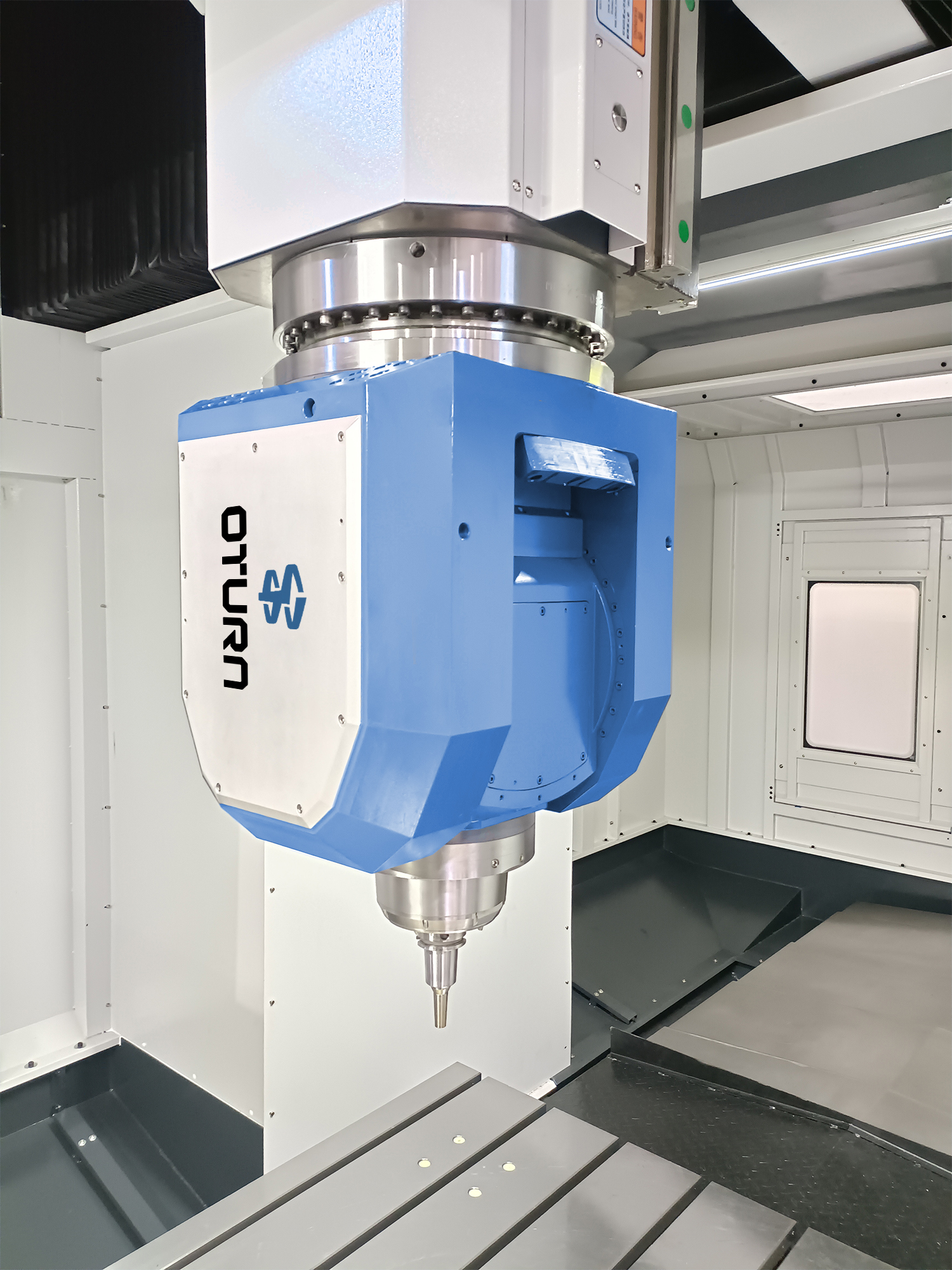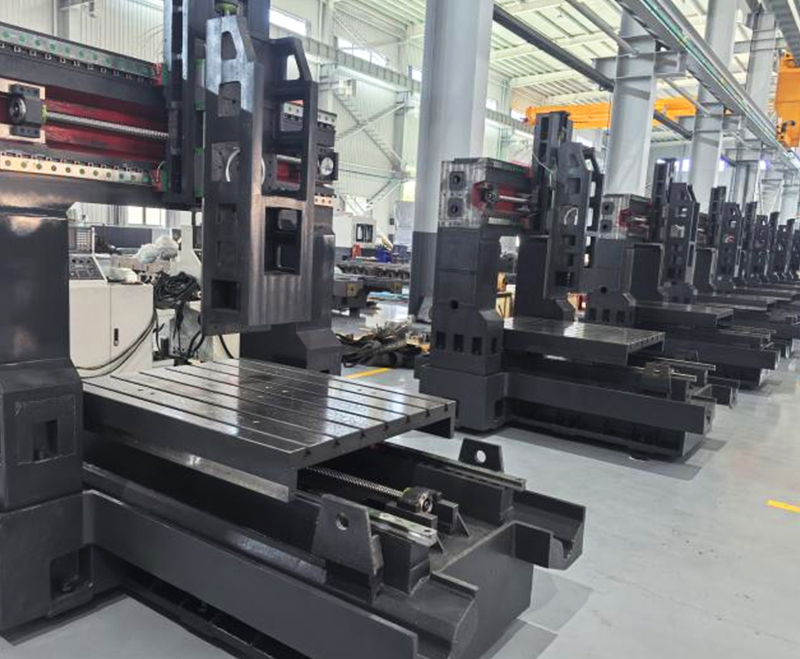Due to their strong rigidity, wide workpiece capacity, and efficient multi-process collaborative execution, CNC gantry machining centers are widely used in large molds, aerospace, energy equipment, and heavy machinery manufacturing. To truly understand the performance of a gantry machining center, it is necessary to analyze its core components and their process functions, thereby grasping its stability and machining accuracy in actual production.
1) Bed and Gantry Mechanism: The Foundation of Rigidity and Stability
The “gate”-shaped frame of a gantry machining center consists of the bed, crossbeam, and two columns. The bed is typically made of high-strength cast iron and undergoes an aging treatment to enhance thermal stability and deformation resistance. The crossbeam connects the two columns, transmitting lateral and longitudinal turning forces to ensuring a stable machining path even under large intermittent or heavy turning conditions. This core structure directly determines the effectiveness of vibration suppression and long-term thermal deformation control during machining, and is the foundation for high-precision machining. This coordinated structure enables the subsequent motion and spindle systems to maintain consistency under high loads.
2) Spindle System: A Direct Reflection of Turning Performance
The spindle is the “heart” of a CNC machining center. Its design directly impacts the transmission of turning force to the tool, the finish of the machined surface, and tool life. A variety of spindle configurations are available to meet machining requirements: high-speed spindles are suitable for fine machining and small-tool turning, offering high speeds and excellent surface quality; high-torque geared spindles excel at roughing and heavy turning, ensuring stability at high feed rates. Spindle systems are typically equipped with constant-temperature cooling and high-precision bearings to suppress thermal expansion and reduce radial runout, thereby maintaining consistent machining accuracy over long periods of operation.
3) 3-Axis Motion System: Positioning and Repeatability
The X, Y, and Z-axis motion system is crucial for achieving complex geometric machining. Common drive methods include high-precision ball screws, linear guides, and hydrostatic guides, achieving low backlash, high rigidity, and excellent repeatability. Dual-drive synchronization is particularly important in applications involving large spans, such as the Y-axis. It effectively eliminates crosshead movement and vibration, improving positioning accuracy and dynamic response speed, thereby shortening machining cycles and enhancing production line stability.
4) Ram and Head Mechanism: Flexibility in Multi-Axis and Angle Processing
The ram is the direct interface for controlling workpiece machining depth and surface shape. Common configurations include open and closed types, each designed to meet different process requirements. Some models integrate a retractable ram at the Z-axis end, or even incorporate a CNC oscillating head (A/C axis) for five-axis simultaneous machining. This flexibility enables gantry machining centers to simultaneously handle complex curved surfaces, inclined holes, and multi-faceted machining, significantly expanding machining capabilities and process path flexibility.
5) CNC System and Simulation: An Intelligent Bridge from Programming to Execution
Modern gantry machining centers are typically equipped with advanced CNC systems, such as those from Siemens and Heidenhain, offering a rich set of machining instructions, tool compensation, online measurement, and simulation capabilities. A graphical interface simplifies programming, while powerful data processing capabilities ensure smooth and precise multi-axis coordinated motion. Advanced simulation capabilities can predict interference, tool paths, and machining time before machining, helping process engineers optimize programs and reduce trial turning costs.
6) Automatic Tool Changer and Tool Magazine: Key to Improving Production Efficiency
The design of the ATC (automatic tool changer) and tool magazine directly impacts the machine tool’s continuous machining capability. A chain-type or basket-style, high-capacity tool magazine, combined with fast robotic gripping and tool changing, can significantly reduce idle time and improve the efficiency of unit workpiece machining time. For high-volume production, a dual-tool magazine design can even be an effective solution for increasing production line throughput.
7) Important but often overlooked supplementary components
· Drive and Cooling System: Precise linear guides, high-quality ball screws, and an efficient cooling system work together to ensure thermal stability and turning rigidity during machining, minimizing tolerance drift caused by thermal deformation.
· Enclosed Guarding and Chip Evacuation System: A fully enclosed enclosure and efficient chip evacuation design not only protects the operator but also minimizes the impact of chips from the work environment on the machine tool and workpiece, thereby improving surface quality consistency.
· Monitoring and Error Compensation: Functions such as posture sensing, non-destructive in-process measurement, and tool radius compensation dynamically correct machining errors and improve the consistency of repeated machining.
· Foundation and Support System: The rigidity of the foundation structure, the quality of drilling and mounting fastening, and the thermally coupled control of the machine layout are all implicit guarantees for maintaining high precision over the long term.
8) Selection Recommendations Based on Application Scenario
· For large components and multi-process machining: Prioritize gantry machines with highly rigid beds, deep cavity machining capabilities, and 5-axis simultaneous to ensure smooth machining paths and stable clamping.
· For high-volume, high-stability requirements: Prefer systems with large tool magazines, fast tool changes, and powerful simulation capabilities to reduce downtime and improve yield.
· For automation integration requirements: Prioritize models compatible with robots and feeder systems to ensure end-to-end automation and data traceability of the process.
Conclusion
This in-depth analysis of the functions of the various components of a gantry machining center reveals its comprehensive advantages in rigidity, positioning accuracy, machining flexibility, automation support, and intelligent control. In addition to the core components mentioned at the beginning of this article, supporting systems such as transmission, cooling, chip removal, protection, and monitoring are also important factors in determining machining quality and production efficiency.
In actual selection and process optimization, only by combining the specific workpiece material, machining allowance, batch size, and automation requirements can we truly achieve “efficient, stable, and traceable” modern processing and production.
Post time: Oct-31-2025









